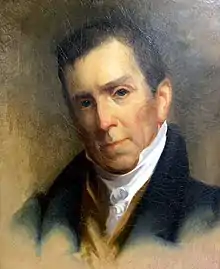William Darlington | |
|---|---|
 | |
| Member of the U.S. House of Representatives from Pennsylvania's 2nd district | |
| In office March 4, 1819 – March 3, 1823 | |
| Preceded by | See below |
| Succeeded by | See below |
| In office March 4, 1815 – March 3, 1817 | |
| Preceded by | See below |
| Succeeded by | See below |
| Personal details | |
| Born | April 28, 1782 Birmingham Township, Chester County, Pennsylvania |
| Died | April 23, 1863 (aged 80) West Chester, Pennsylvania |
| Resting place | Oaklands Cemetery |
| Political party | Democratic-Republican |
| Education | University of Pennsylvania School of Medicine |
| Occupation | Physician, botanist, politician |
| Signature | |
William Darlington (April 28, 1782 – April 23, 1863) was an American physician, botanist, and politician who served as a Democratic-Republican member of the U.S. House of Representatives for Pennsylvania's 2nd congressional district from 1819 to 1823.[1]: 67
Early life and education
William Darlington (cousin of Edward Darlington and Isaac Darlington, second cousin of Smedley Darlington) was born in Birmingham, Chester County, Pennsylvania. He attended the Friends School at Birmingham and spent his youth on a farm.[2] He became a botanist at an early age, studied medicine, and graduated from the medical department of the University of Pennsylvania in Philadelphia in 1804. He went to the East Indies as ship's surgeon in 1806. He returned to West Chester, near Birmingham, in 1807 and was a practicing physician there for a number of years. He raised a company of volunteers at the beginning of the War of 1812 and served as major of a volunteer regiment.[3]
Political and later career


Darlington was elected as a Democratic-Republican to the Fourteenth Congress. He was again elected to the Sixteenth and Seventeenth Congresses. He was appointed canal commissioner in 1825, and served as the first president of the West Chester Railroad from 1831 to 1835.[2][4]
In 1823, Darlington was elected to the American Philosophical Society.[5]
He established a natural history society in West Chester in 1826 and published several works on botany and natural history. His published works include Mutual Influence of Habits and Disease (1804), Flora cestrica: an attempt to enumerate and describe the flowering and filicoid plants of Chester County in the state of Pennsylvania (1837) and Agricultural Botany (1847).[3][6] Several others also contributed to the Flora cestrica, making it a collaborative effort. These included Thomas Potts James who wrote the section about mosses and liverworts[7] and Ezra Michner also contributed to this book.[8] Abigail Kimber had provided plant specimens to Darlington and these are also cited in the book.
The degree of L.L.D. was conferred on him by Yale University in 1848, and he was awarded a Doctor of Physical Science in 1855 by Dickinson College.[3] The California pitcher plant, Darlingtonia californica, was described by John Torrey in 1853 and named in his honor.[9] The Academy of Natural Sciences of Drexel University preserves some botanical specimens that he collected — for example, of Talinum teretifolium (Phemeranthus teretifolius — the quill fameflower).[10]
In 1849 he published Memorials of John Bartram and Humphry Marshall; with notices of their Botanical Contemporaries.[11]
He served as director and president of the National Bank of Chester County from 1830 to 1863, where his friend and fellow botanist David Townsend was chief cashier. He died in West Chester in 1863, and was interred in Oaklands Cemetery.[12]
References
- ↑ Makers of American Botany, Harry Baker Humphrey, Ronald Press Company, Library of Congress Card Number 61-18435
- 1 2 "DARLINGTON, William, (1782 - 1863)". Biographical Directory of the United States Congress. Retrieved August 2, 2013.
- 1 2 3 Wilson, James Grant; John Fiske (1900). Appleton's cyclopaedia of American biography. New York: D. Appleton. Retrieved July 13, 2013.
- ↑ Moore, Paul (Spring 2002). "The West Chester Railroad Company". The High Line. 18 (1): 5, 10.
- ↑ "APS Member History". search.amphilsoc.org. Retrieved April 6, 2021.
- ↑ "Agricultural botany [microform] : An enumeration and description of useful plants and weeds, which merit the notice, or require the attention, of American agriculturists". 1847.
- ↑ Gozzaldi, Mary Isabella James (1903). "Thomas Potts James". The Bryologist. 6 (5): 71–74. doi:10.1639/0007-2745(1903)6[71:TPJ]2.0.CO;2. JSTOR 3238779.
- ↑ Shear, C L; Stevens, Neil E (1917). "The Botanical Work of Ezra Michener". Bulletin of the Torrey Botanical Club. 44 (12): 547–558. doi:10.2307/2479639. JSTOR 2479639. Retrieved March 6, 2023.
- ↑ Rice, Barry. "Darlingtonia: the cobra lily; The Carnivorous Plant FAQ v. 11.5". The International Carnivorous Plant Society. Retrieved August 2, 2013.
- ↑ "Mid-Atlantic Herbaria". midatlanticherbaria.org. Retrieved December 1, 2020.
- ↑ Hooker, William Jackson (1850). "Review of Memorials of John Bartram and Humphry Marshall; with notices of their Botanical Contemporaries by William Darlington". Hooker's Journal of Botany and Kew Garden Miscellany. II: 62–65. (See John Bartram & Humphry Marshall.)
- ↑ Kestenbaum, Lawrence. "Darlington-Butler family of West Chester, Pennsylvania". www.politicalgraveyard.com. The Political Graveyard. Retrieved November 14, 2022.
- ↑ International Plant Names Index. Darl.
Sources
- daguerreotype
- Lansing, Dorothy I. That Magnificent Cestrian: Dr. William Darlington, 1782-1863, Being a Short Introductory Biography. Paoli, Pennsylvania: Serpentine Press, 1985.
- Author:William Darlington wikisource